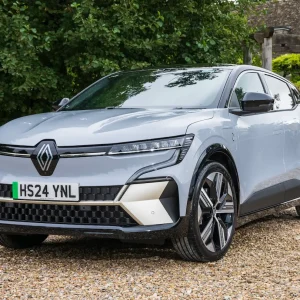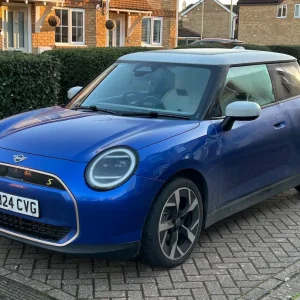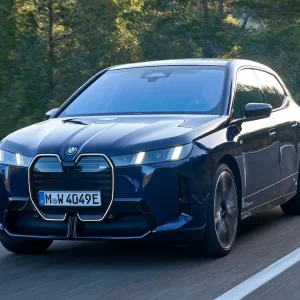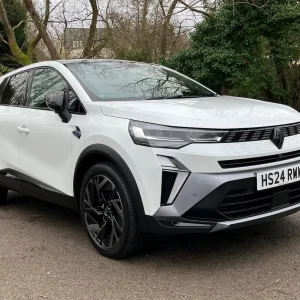We’ve already marvelled at how well the latest Range Rover drives, which resulted in it winning the Driver’s Choice awards at the 2022 Business Car Awards. Combined with the luxurious hi-tech interior, this is an opulent off-roader that rivals will be jealous of.
Let’s be honest though, when fitted with ICE diesel and petrol power, the Range Rover ends up in the highest 37% BIK band. With list prices starting at over £100,000, the Range Rover is not an affordable car to buy and run on the company.
All-electric versions of the Range Rover are due this year, but until then, the more affordable powertrain options are the P440e (that we have here), or the even more powerful P510e plug-in hybrid models. The P11D price of our Autobiography spec test car might be nibbling £130,000, but despite this, our Range Rover slotted into the much more affordable 8% band.
The P440e combines Land Rover’s 3.0-litre straight-six Ingenium petrol with a 105kW electric motor and 38.2kWh battery hidden under the back seat. This is the same as the Range Rover Sport driven in the January issue. We think being a plug-in hybrid suits the current Range Rover’s refined character better, adding another layer of refinement and serenity, as it starts in full-electric. It can be left in full EV mode, but we preferred hybrid, where it switches to petrol at higher speeds. Still impressively refined, the only way I could tell the engine was running was via the rev counter! This Range Rover makes the most of its EV range, and at higher speeds it happily switches back to EV power. Acceleration to 60mph takes 5.7 seconds yet is still capable of covering 69 miles on electric power alone – although during the cold weather, when we drove this Range Rover, 50 miles was closer to the mark.
Outside, apart from the extra filler flap on the left, the Range Rover PHEV is unchanged from other ICE models. It is a handsome-looking car, and the rear, with its thin, vertical lights remains the biggest talking point. However, the scrolling indicators hidden in the boot panel stand out far less than they did at launch.
Inside, the Range Rover’s ‘calm sanctuary’, as Land Rover refers to the interior, remains unchanged. So, the dashboard is dominated by the 13.1in tablet-style ‘Pivi Pro’ navigation system in the centre console. Elsewhere, there’s the same two-spoke multi-function steering wheel and impressively comfortable seats with various massaging options. With average rear legroom it’s nearly as nice to be driven in. Boot space is a practical 818 litres – even with the optional, rear-mounted pop-up seats.
With soft dark leather covering almost every surface, combined with a subtle dark wood trim, the feel was classier than the First Edition model that we drove at the launch. Take the chrome edging off the stalks and they feel identical to those in Range Rovers from 20 years ago. Still, they work well enough, but don’t feel as special as the rest of the interior. Then there’s the curved infotainment screen, which looks good and works well, but I can’t help thinking it would look better being sunk into the dashboard.
We couldn’t spot any obvious difference in the ride of the PHEV version of the Range Rover. Composed and comfortable whatever the surface, our car was on (slightly) smaller 22in wheels – which may have had an effect. We think it’s more down to the clever electronics constantly monitoring the road surface and reconfiguring when there’s a need. Slightly disappointing was the odd fidgety feel at high speed.
The extra weight of the hybrid kit doesn’t appear to have made a difference to the handling either. Considering its 2.7-tonne weight, the way this car resists roll is impressive – although this is mostly down to the clever 48V active roll-control system. It is not as dynamic as the Sport, but this Range Rover is more involving than you might expect.
We didn’t get the chance to drive this Range Rover off-road, but hybrid drivetrain or not, we’re told it’s as capable as the standard car.
So, is the plug-in hybrid version of the latest seventh-generation Range Rover the pick of the range? We believe so, as there seem to be few compromises, making an already complete luxury package far more affordable to run.
Range Rover 3.0 P440e Autobiography
P11D: £127,610
Residual value: 56.87%
Depreciation: £55,033
Fuel: £8,370
Service, maintenance and repair: £5,463
Cost per mile: 114.78p
Fuel consumption: 323mpg
CO2 (BIK %): 20g/km (8%)
BIK 20/40% a month: £170/£340
Luggage capacity: 818 litres
Engine size/power: 2,997cc/440hp





